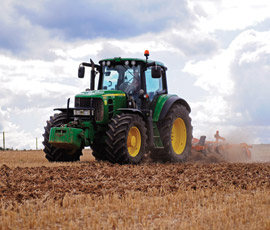Rapeseed drilling picks up pace in the dry

A late surge in oilseed rape drilling, boosted by dry weather and a better-than-expected 2013 harvest, could see this season’s rapeseed area grow close to last season’s.
Many had expected a fall in the rapeseed area after a tough growing season and a decline in rapeseed prices, but good weather has seen many complete drilling during August.
Traders report seed sales are down this season, but with many crops in the ground well established there is likely to be fewer ripped up this winter.
Harvest forecasts have edged up to about 2m tonnes, with yields better than first thought, and this, along with dry drilling weather, has encourage growers to stick with the crop.
Cultivation work begins as the clouds gather, says Lucy Blain, who took the picture above at Sulhampstead, Berkshire. Much of the early-worked land across the country is destined for oilseed rape.
“The area might be stable to down a bit, but we are not expecting any new records and not any mass exits,” says HGCA analyst Jack Watts.
The HGCA estimate this year’s harvested crop fell 9% to 686,000ha from 2012’s 756,000ha, but traders believe it could be as low at 650,000ha.
Two months ago, harvest estimates were about 1.8m tonnes, but many now look toward a national crop of about 2m tonnes.
“We see a harvest of 2.1m tonnes with yields down 7-10%,” says United Oilseeds trading manager Owen Cligg, who predicts a crop area for harvest 2014 of 600,000-650,000ha.
Jonathan Lane, trading manager at Gleadell, sees a crop of a 1.9-2m tonnes, with yields better than forecast back in the spring.
Traders say the rapeseed heartland of East Anglia and Lincolnshire is expected to see “normal” plantings, but further north and west could see falls after a difficult harvest.
With many new crops emerging early, agronomists say growers should be looking at plant growth regulators (PGR) and disease control of phoma and light leaf spot.
“With some crops well ahead at the four-leaf stage, growers should be considering using a PGR,” says Christine Lilly, technical support manager at adviser Frontier.
She suggests using a triazole fungicide such as metconazole or tebuconazole to control growth, with the only downside being that these are not as active on diseases as other fungicides.
One Rutland grower in central England is still waiting to cut his crop on an east-facing slope that was hit by the cold weather and slug damage.
“We hope to combine the crop this weekend and if we get 2.5t/ha we will be happy,” says Andrew Brown from his 252ha Fairchild’s Lodge, near Caldecott, where he grows 58ha of rapeseed.
He cut his Cabinet variety in the second week in August, yielding 3.75t/ha, but his ExPower was very uneven and it was touch and go whether it should be ripped up.
This crop has been in the ground for 13 months and was sprayed off on 30 August, and Mr Brown is in the bizarre situation of having 2014 harvest rapeseed growing well while the 2013 crop is still in the field.

